Aroma classification of orchids
Orchids that have some sort of - pleasant or unpleasant - odor are less common than plants without a scent. In nature, this is far from the case, but it is completely odorless plants that dominate among indoor species.
All orchids can be roughly divided into three categories:
- species and varieties devoid of or almost devoid of odor;
- types and varieties with an unpleasant odor;
- species and varieties with a pleasant aroma - light, subtle or very bright, which divides this category into three subspecies:
- orchids, the smell of which is heard only from a distance of less than 50 cm;
- varieties with a scent perceptible at a meter distance from the plant;
- orchids with a strong odor, which is felt even from a distance of more than 3 m.
Orchids do not always reveal their scent immediately and often do not smell at all predictable times. Some varieties are similar to any tropical flowering crops and smell good, especially in the dark. Others - only in the evening, others - at dawn and in the morning, and there are those whose aroma does not change during the day.
They also differ in the manifestation of their aroma as the flower blooms: along with orchids, in which flowers smell immediately after opening, there are also those in which you will have to wait up to 4-5 days after the blooming of the flower before any smell appears ...
Orchid aromas differ, although most often the plants are associated with their cousin vanilla, also belonging to the huge Orchid family. Orchids with a pleasant aroma surprise with sweet, spicy, surprisingly festive overtones.
Floral-refined scents among orchids are less common than fruity trails - from the aroma of green apples to orange or lemon peel, melon, and watermelon.
Many people call orchid scents confectionery. Indeed, almost always their smell evokes associations with spices or goodies - chocolate, vanilla, spices, honey.
Read on for a list of the best spicy orchids.
Is Puia Raymonda the rarest plant in the world?
Puia Raymonda in appearance resembles a thorn with a long trunk. It blooms only once in a lifetime, and dies a few days after that. The life cycle is 150 years.
The homeland of the plant is Peru and Bolivia. If you try hard, you can find several copies of this unique plant, but under the influence of various factors (human, natural), the plant dies so quickly that it will soon completely disappear.

The main reason for the decline in the number of Puia Raymonda is fires and human damage.
There are many plants in the world, the existence of which on this planet may end. And in many respects the reason for this was the human factor. Deforestation, vandalism, abuse - all this time and again reduces the number of plants.
It is so important to understand this now so that our descendants can admire the mighty crowns of birches and maples.
After all, if we - people do not pay attention to this now, perhaps in a short time, even plants familiar to us with a large area may be under the threat of extinction.
Orchid care at home
Lighting
Proper lighting is a major factor in the care of your home orchid. The plant needs 12-15 hour daylight hours, so additional lighting will be required on short winter days. In other seasons, it is better to place the plant on the east or west side of the room, closer to the window. The south windows will have to be shaded; on the north side, you will need constant fluorescent lighting.
Flying Duck Orchid (lat. Caleana major)
Temperature regime
The temperature regime for an orchid depends on the type of plant.Phalaenopsis and other tropical orchid species are kept in summer at temperatures up to +32 degrees, during winter night hours the temperature should not fall below +15.
Dendrobiums, miltonia and other species native to the subtropics prefer a more gentle atmosphere: +22 in summer daytime hours and + 12-15 degrees in winter.
The indoor orchid grows well and blooms at an air humidity of 60-70%. Spraying has a short-term effect and, unfortunately, contributes to the development of infections and leaf rot. Therefore, the best option would be to use air humidifiers, install open containers of water and moisten the gravel in the pan. Spraying the orchid should be minimized, being careful not to get water on the flowers.
Watering
"How to water an orchid correctly?" - a question that worries many lovers of this beautiful plant. Orchids cannot tolerate stagnant water, which can lead to yellow leaves and root rot. For watering orchids, it is better to use soft water - rain, thawed or boiled. Summer watering of an orchid is carried out after the soil or substrate dries up, 2-3 times a week, in winter it is rarely watered, as soon as the pseudobulb begins to wrinkle.
Transfer
Orchids need to be transplanted only if necessary; this process is often replaced by transferring to a larger container. The best "dwellings" for a flower are ceramic or plastic pots with holes in the walls or a basket.
Brick fragments or granite crushed stone are used as drainage, which is filled with 1/4 of the container. Holes and slots are laid with sphagnum. The substrate is prepared from 5 parts of pine or willow bark, 2 parts of sphagnum and 1 part of charcoal. If you add crushed fern rhizomes, fallen leaves of trees and peat to the mixture, you can do without top dressing. The orchid is carefully lowered into the container, the fragile roots are straightened and the voids are filled without compacting the substrate. Then the plant is fixed with wire and is not watered for 5 days.
Radiation guide (lat.Pecteilis radiata)
With a timely (once every 2-3 years) transplant, orchids can do without feeding at all, getting the necessary nutrition from the substrate. An excess of fertilizer suppresses the plant's immunity, which reduces orchid flowering and leads to infections. A high concentration of mineral salts can lead to the death of the plant, and if it becomes necessary to feed the orchid, it is better to use special fertilizers: Bona Forte, Kristalon, Pokon, Compo or Greenworld. When using any fertilizer for orchids, the recommended dose should be halved. Orchid feeding is carried out only in spring and summer, during the period of plant growth.
To stimulate flowering, it is advisable to treat orchids with the preparations "Ovary", "Bud", "Blossom".
Oncidium warty (Latin Oncidium varicosum)
Phalaenopsis rosea (Phalaenopsis rosea)
Reproduction
Representatives of various species and even genera are capable of interbreeding and producing numerous hybrids. Targeted interspecific pollination has given birth to hundreds of thousands of artificial orchid hybrids, many of which have become favorite houseplants. Representatives of the genera Phalaenopsis, Cattleya and Dendrobium are especially popular. Each type of orchid has individual recommendations for the conditions of maintenance and general rules for all types of care and breeding.
Orchids are propagated in any of 3 known ways:
- lateral stem shoots - children, which are separated from the mother plant and planted separately;
- layering - air suckers, by rooting on the mother plant in a special greenhouse and with subsequent separation;
- vegetatively, dividing the rhizome and planting fragments containing 2-3 pseudobulbs.
Bloom
With proper lighting and proper care, the orchid can bloom 2 times a year, in spring and autumn. Non-infectious diseases in a plant occur due to hypothermia, excessive watering, insufficient lighting, and sunburn.Long-term negative impact is fraught with the death of the flower.
Golden orchid
Black Orchid
Rare representatives
Coleman
This orchid with brown stems (due to the lack of chlorophyll in them), with flowers of purple hue grows in the mountains of Arizona. It is extremely difficult to find it. Even the process of pollination of Coleman's orchid remains a mystery to botanical scientists. Only 200 specimens of the plant have been found in the wild.
Rothschild's slipper
The cost of such an orchid reaches 5 thousand dollars, and you can get it, perhaps, only on the black market. It blooms once every 15 years. It looks just like a purple slipper. Rothschild's Slipper Orchid is the most expensive orchid in the world.
Dancing girls
A rather rare plant, Impatiens Bequaertii. The appearance of the orchid resembles white dancing girls in skirts and with their hands up. The variety is capricious and does not tolerate inappropriate growing conditions. More common in breeders than in the wild.
Ghost
This orchid is named not only for the flower that looks like a white ghost, but also for its extremely rare occurrence. The Ghost Orchid was first discovered in the UK in 1954. Since then, the plant has been seen 11 more times in nature. The height of the orchid is small - only 15 cm.
Threebirds orchids
Although the name of the orchid is unusual, but the appearance is rather ordinary: small green leaves as large as a fingernail, a purple stem and pale pink inflorescences. Endangered. The last copies remained only in North America and New England.
Dragon mouth
Arethusa bulbosa grows in lowlands and marshes, originating in North America. A single-leafed stem forms a large purple flower with yellow ridges, resembling a crown. A short-lived plant that blooms a couple of years before death.
Breeders often refer to unusual types of orchids as collectible. Although because of this, the cost of planting material is growing, but the result of cultivation will delight the grower for a long time.
The area of distribution of species in nature
Large-flowered orchids, such as Cattleya, Phalaenopsis, Pafiopedilum, Cymbidium, were brought to Europe from:
- Tropikov;
- And subtropics;
-
Many of the mountainous regions.
Most of the species are epiphytes, some are lithophytes; there are species and whole genera growing on the soil. Orchids have mastered all continents of the Earth, with the exception of only Antarctica. The number of genera, species and hybrids is so great that they occupy a tenth of the planet's flora.
Orchids feel best in the subtropics:
- Southeast and South Asia;
- Northern Australia;
- Brazil.
There are optimal temperatures (and their seasonal / daily differences), humidity, length of the day by seasons, illumination. Second distribution area:
- Line connecting South and Central America;
- And North Africa.
At times, 100% humidity and warmth are beneficial factors for orchids.
The third, the most severe territory for the family is the steppes and plateaus of Eurasia. Small and medium-sized species grow here. There is even an orchid with one large flower.
More types and varieties of pink phalaenopsis orchids
In the collections of florists, you can find both specific phalaenopsis and hybrid varieties with pink flowers.
Schiller
Among the most common are Schiller's phalaenopsis (Phlaenopsis chilleriana). Homeland - Philippines. The peculiarity of the species is in variegated leaves with a silvery coating, with spots of dark green color, combining into stripes.

Phalaenopsis Schiller ‘Wilson’.

Phalaenopsis schilleriana - photo from Wikipedia.
It is this type of phalaenopsis that is the "father" of most hybrids. The huge number of flowers on the peduncle is another highlight. A record case - 174 flowers per peduncle!
Stewart
Phalaenopsis Stuartiana (Phlaenopsis Stuartiana) is very similar to the previous species. The difference is in a branching peduncle with medium-sized flowers with a specific pattern. Homeland - Mandanao Island in the Philippine archipelago.
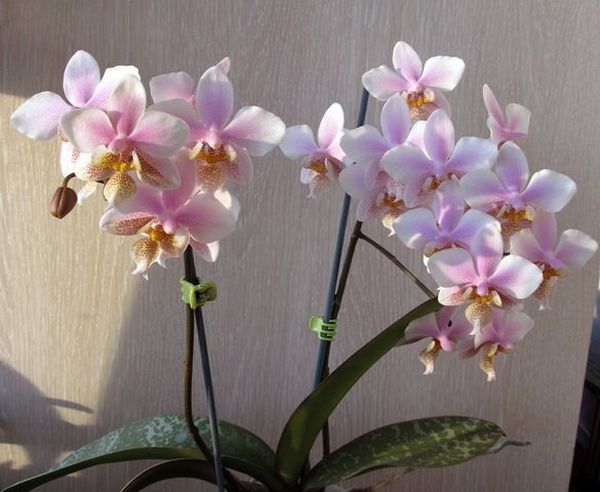
Phalaenopsis Stewart.
Mini and midi
Phalaenopsis mini are distinguished by their miniature size. Midi orchids are slightly larger - 40-55 cm high, with a leaf length of up to 20 cm and a peduncle thickness of about 7 mm. Among them there are also flowers with a pink color.

Phalaenopsis mini. Write in the comments, please, what kind.
Hybrids
Phalaenopsis orchid hybrid varieties:
- pink-cherry phalaenopsis;
- pink Dragon;
- singolo pink;
- pink Panther;
- pink dreams;
- Grandiflora Chameleon pink;
- royal terry pink phalaenopsis.
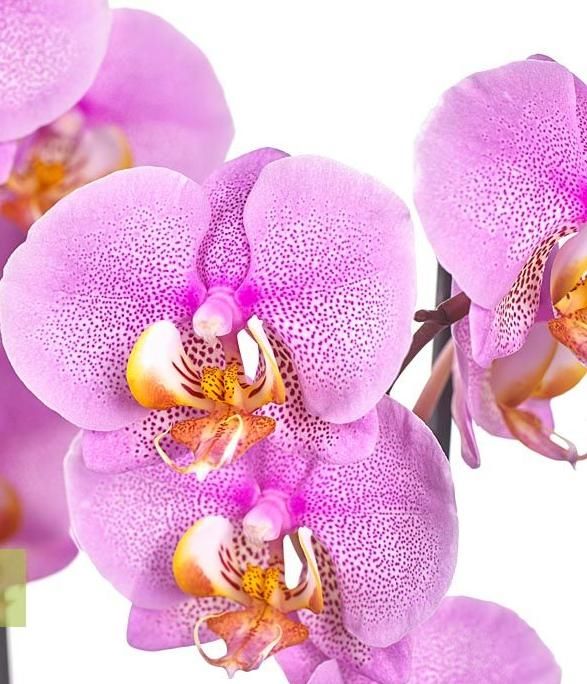
Phalaenopsis Pink dragon.
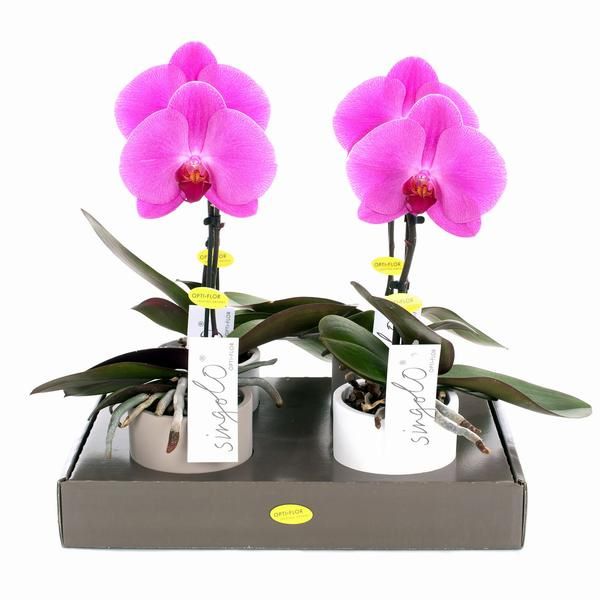
Pink Phalaenopsis Singolo.
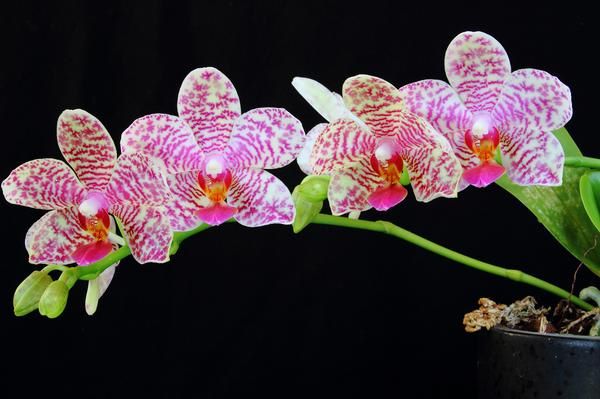
Pink Panther (Phal. Pink Panther).
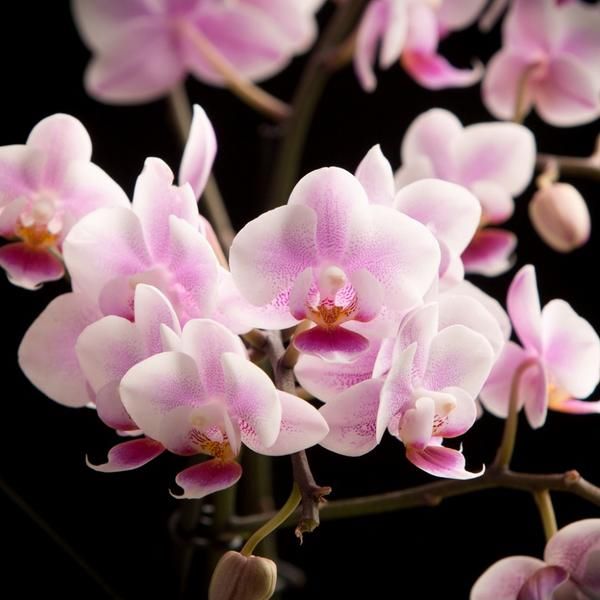
Phalaenopsis Pink Dream
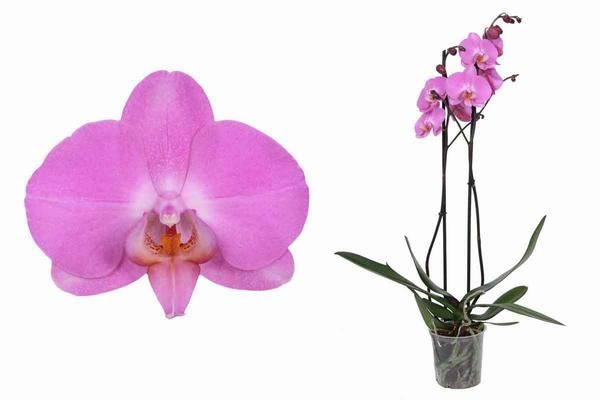
Grandiflora Chameleon.

Pink royal phalaenopsis.
Growing features
These orchid varieties are bred by breeders and do not require any unique conditions for keeping, however, some rules must still be followed:
temperature regime. Since they all come from the hot tropics, the optimal temperature regime is considered to be up to 30 degrees during the day and not lower than 18 degrees at night;
illumination. Almost all large orchids like indirect bright sunlight (with the exception of the Dracula orchid). Therefore, in the summer, it is recommended to keep the flowerpot with the plant under indirect bright sunlight, and use special fluorescent lamps at night;
watering and humidity levels. Based on the conditions of natural habitation of these varieties, it can be concluded that the humidity in the room should be high enough up to 80-90%. It is necessary to water the plant as the soil dries, it is best to do this by immersing the pot in a container of water;
reproduction. It is carried out in two ways - dividing and grafting. In the first case, in early spring, the root system is carefully divided into several parts and planted in different flowerpots. For better growth, it is necessary to recreate greenhouse conditions. In the second case, a "baby" is used, which the plant throws out from time to time;
substrate
It is very important to choose the right proportions of the soil in order to provide the plant with a sufficient amount of air and access to moisture. For this, it is better to use ready-made mixtures that are sold in flower shops.
Advice! In order to maintain a normal humidity level, it is necessary to periodically humidify and ventilate the room where the orchid is located.
Pleione
Pleione is a baby orchid 10-22 cm tall, native to the foothills of India and China, and also lives in the central regions of Nepal and Vietnam, Burma, Laos and Thailand. According to different sources, the genus is called 19-22 natural species and 5-6 hybrids.
Named after the mythical Pleione, the parent of the Pleiades, probably due to the ability to form whole clusters of daughter tuberidia-cones around the mother's pseudobulb the size of a walnut. On the top of an adult pseudobulb, 1 or 2 elongated-oval leaves are formed, and at the base there are 1–2 flowering stems with a single flower of dull yellow, snow-white, lilac-crimson, soft coral color.
Pleione photo
Orchid (flower): description and photo
Orchid flowers make up one of the most numerous plant families, the main part of which in nature is perennial grasses. Shrub form and woody lianas are less common. Orchids can range in size from a few centimeters, although individual species grow up to 35 meters in height.
Most of the orchids are epiphytes that grow on other plants, using them as a support and are not parasites. Epiphytic orchid flowers do not depend on the soil, receive more light and suffer less from herbivores.

Orchid epiphyte
The roots of the epiphyte orchid are extremely important organs as they perform many essential functions.
First, with their help, orchids are attached to the substrate, which allows them to maintain an upright position. Second, the roots are actively involved in photosynthesis, sharing this function with the leaves.Thirdly, with the help of the root system, orchid flowers absorb moisture and nutrients from the air and bark of the plants on which they live.

Another, smaller part of orchids are lithophytes growing on rocky and stony rocks. Terrestrial orchids make up the medium-sized group.
Both types are endowed with underground rhizomes or tubers.

Orchids lithophytes
The green stem of an orchid can be long or short, creeping or erect. Leaves are simple, alternate, on each plant there may be one or more of them.
Orchid flowers of the most varied colors and sizes form 2 types of inflorescences: a simple ear with a single arrangement of flowers or a simple brush with several flowers on pedicels growing along the stem.
The orchid flower belongs to insect pollinated plants, and the mechanisms of pollination of each species are sometimes unusual and very diverse. Orchids-shoes, which have a "shoe-like" flower structure, are endowed with a special trap for pollinating insects.
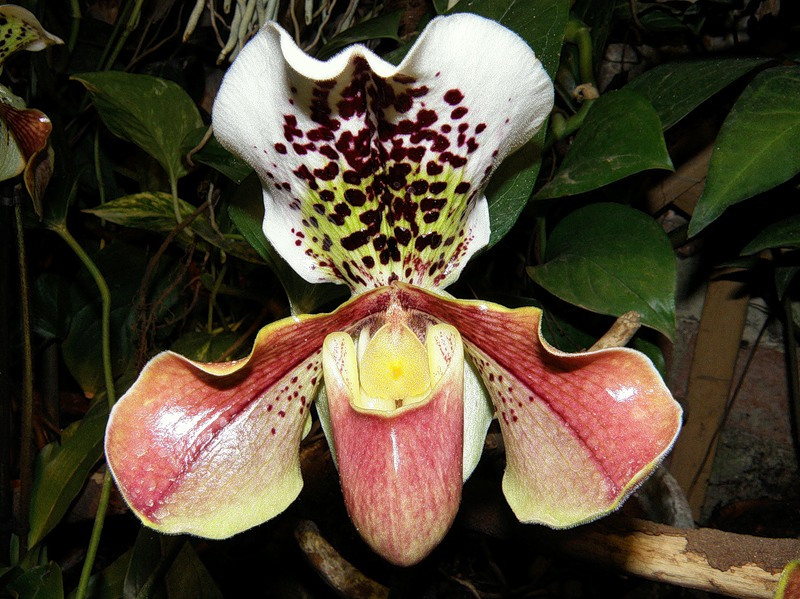

Orchis have sticky legs, the flowers of this orchid mimic the smell of female bees, thereby attracting males.
Flowers of tropical orchids intoxicate insects with an unusual aroma, other species shoot pollen towards the pollinator insect.
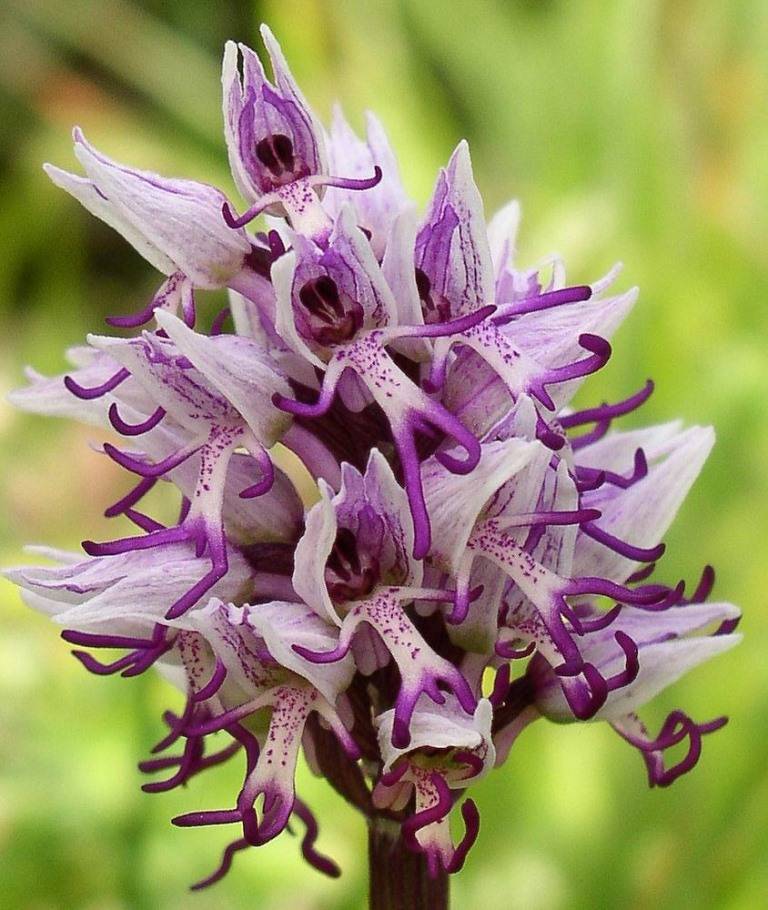
Orchis
The orchid fruit is a dry capsule containing up to 4 million microscopic seeds, which is a kind of productivity record among flowering plants.
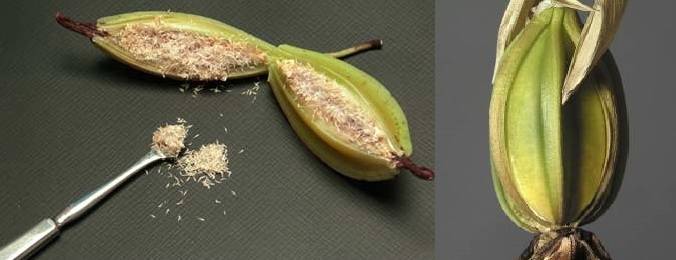
Orchid fruit
The life span of orchids in natural conditions is individual, depends on many factors and under favorable conditions can be 100 years. In greenhouse conditions, many types of orchids live up to 70 years.
Nepenthes Attenboroughii.
This unusual, interesting flower was discovered on the island of Aalavan by three scientists in 2000, who went on an expedition to find this miracle of the flora. The first information about the flower was received from missionaries who had visited the island earlier. Having gone to Mount Victoria, scientists discovered huge flowers, the inflorescences of which resembled volumetric jugs.

It turned out that these unusual flowers are real predators that feed on rodents. It still remains a mystery how these flowers were able to survive to this day. This phenomenon is being studied today in MacPherson's laboratory. How do you think, custom bouquets of these flowers would be in high demand?
Bloom
When and how?
In natural conditions (rainforests), the orchid begins to open its buds at the end of the rainy season, the duration of which can be up to several months.
Flowering usually occurs at the end of November. However, in home growing, you can see flowers in full bloom at any time. The main thing is to provide the necessary conditions for this. Moreover, the buds can bloom several times a year. But do not get too carried away with this, since flowering requires a lot of strength from the orchid. And if this process is very long or frequent, phalaenopsis may start to hurt due to lack of energy.
Care before and after blooming
Before the first flowers appear, orchid care should be standard (it will be described in the article below). But after flowering, phalaenopsis, due to its weakening, requires special attention and approach. After dropping all the buds from the peduncles, the florist must perform the following actions.
- Cut off the peduncle.
But this does not need to be done right away. It is worth waiting until it is completely dry. Previously, this should never be done, because it is in the flower arrow that all the nutrients are stored that help Bill Lipa to recover after the blooming of the buds.
- It is necessary to remove the peduncle correctly.
If it has dried completely, then it must also be cut off completely, leaving a couple of centimeters. If the arrow is partially dry, then you need to cut it off so that there is still a couple of centimeters of dry area above the green part. Do not touch the swollen buds - this is a guarantee of the next flowering.
- The cut areas need to be processed.
This is best done with regular wax. Such manipulation will close the "sore" place, preventing moisture from getting inside, and also preventing it from evaporating. This prevents the plant from rotting or drying out.
- Place phalaenopsis in a dark place for seven days.
This will become a kind of rest for the plant. During this period, there is no need to moisten the soil, and even more so to apply fertilizers.
- After restoration, if necessary, transplant Leontina.
What if it doesn't bloom?
In order for an orchid to please with its flowering, several prerequisites must be fulfilled.
- Provide plenty of light.
But he must be absent-minded. In no case should direct sunlight fall on the orchid areas.
- Choose the correct watering mode.
Don't do this too often. You need to navigate by the roots and soil. Everything should dry out, stand in this form for two or three days, and only then can the soil be moistened again.
- It will be nice if a drought period comes for Phalaenopsis.
This is due to the peculiarities of tropical forests. During heavy rains, there are no insects that pollinate the flower. Therefore, at home, Big Lip thinks that if there is a lot of moisture, then it is not time to bloom.
- Leontin needs to be fed competently.
It is necessary to carefully study the composition of nutritional complexes. If they contain a large amount of potassium, then usually only the green part of the plant goes into growth. In order to achieve flowering, it is necessary to fertilize with complexes, which mainly include nitrogen and phosphorus.
- Create a stressful situation.
This can be achieved in different ways: reduce watering, reduce the frequency of fertilization, rearrange the flower pot in a darker place. This method is considered extreme. It is used only when the options described above do not help.
Important! Do not get carried away with too frequent change of the place of "residence" of the orchid. This can lead to a deterioration in her condition.
Orchid diseases
Orchid diseases are rare and require specialist intervention:
Bacterial leaf spot
The disease is fairly easy to treat. Isolate the "patient" from other indoor flowers! Remove damaged parts of the orchid by cutting off with scissors. Treat the slices with ordinary brilliant green, cinnamon powder or activated carbon.
Anthracnose
With this disease, be sure to eliminate all diseased parts on the plant! Spray your orchid with Sandofan, Previkur, or Profit fungicides.
Powdery mildew
If there are visible signs of this disease, pour abundantly the container in which the orchid is growing with water several times. After a couple of hours, spray the plant with a solution of colloidal sulfur or Topsin-M.
Rust
The disease is serious but treatable. The orchid plant should be thoroughly rinsed under running water, without fear of flooding it, replace the substrate in the container. Then it is necessary to sprinkle the orchid with a slightly pink solution of potassium permanganate and treat it with the Manual-Orchid agent from a spray bottle.
Root, black, gray, fusarium rot
The places affected on the plant must be removed by cutting off with scissors and sprinkling with crushed activated carbon. Replace the substrate with a new one, before washing the container and orchid roots in a pink solution of potassium permanganate.
Sooty mushrooms
A flower disease can be cured by spilling the substrate twice and spraying the plant with preparations such as "Mikosan" or "Topsin-M".

Below are the answers to the most frequently asked questions from lovers of this plant.
Useful properties and uses of orchids
In addition to exceptional decorative properties, some types of orchids have valuable beneficial properties that are widely used in folk and traditional medicine.
Tubers of certain orchid species contain a large amount of mucus, rich in antiseptics and immunoglobulins, as well as starch and protein. A decoction of the roots of Lyubka two-leaved (lat. Platanthera bifolia) is used for indigestion, inflammation of the bladder, as an analgesic and antiseptic.

Lyubka is two-leaved (lat.Platanthera bifolia)
The roots of the Cremastra orchid (Cremastra appendiculata) are used as a pain reliever and antidote for snake bites.
Dendrobium nobile or noble (Dendrobium nobile) is used for gastrointestinal diseases, pain syndromes and as an aphrodisiac.
Three-fold or triple calanthe (Calanthe triplicata) is used to treat diarrhea, relieve swelling and all kinds of pain.
Royal Anectochilus (Anoectochilus regalis) is a rare epiphytic orchid, from which valuable medicinal oils are obtained.

Ophris bee

Bee ophrys (lat.Ophrys apifera)
Sword-leaved cymbidium
Cymbidium ensifolium is the honeyest of all orchids and the most popular of the cymbidiums. This is a very graceful orchid of the sympodial type with poorly developed, centimeter-wide, completely closed leaf sheaths, pseudobulbs and long roots. Narrow lanceolate leaves from 30 cm to 1 m in length seem stunningly straight and strict, not only due to the folded structure, but also because of the very dark color.
 Sword cymbidium (Cymbidium ensifolium).阿 橋 HQ
Sword cymbidium (Cymbidium ensifolium).阿 橋 HQ
The vertical inflorescences are usually somewhat shorter than the leaves. They bear up to 9 flowers that last for several weeks. With a diameter of 3 to 5 cm, they flaunt beige-yellowish sepals and petals with longitudinal, reddish veins, and sometimes specks, and a greenish lip covered with patterns.
Hybrid Phalaenopsis
Phalaenopsis belong to the orchid family. This type of orchid was first discovered in 1825 on the islands of the Malay Archipelago. After that, these extraordinary plants of various species were found in Southeast Indonesia and the tropical region of Australia. They gave rise to many hybrids and varieties of phalaenopsis.
Standard
The first phalaenopsis hybrids had large white or pink flowers and tall peduncles. They are called standard. Further interspecific selection continued in various directions:
- breeding plants with large flowers;
- brightly colored or variegated petals;
- miniature phalaenopsis, etc.
An example of a Maki Watanabe ‘Kingfisher Orchids’ hybrid (Romance Miki X Otohime)
Mini
In the middle of the last century, miniature phalaenopsis came into fashion. This is a fairly large group of varieties that share common characteristics:
- small flowering arrow;
- small classic-shaped flowers.
Phalaenopsis mini. The size is relative to the size of the lighter.
Taiwanese
Nowadays, Singapore is the trendsetter in the field of orchid breeding, as a result of which plants with pure petals of bright colors or spotted patterns have appeared, for which they were called "harlequins".
Taiwanese phalaenopsis Harlequin.
Novelty
These hybrids include plants with non-dying peduncles. After flowering, they have a dormant period, after which old peduncles grow and new ones form at the same time.
An adult novelty can have several dozen inflorescences that bloom up to 5 times a year. The petals of small flowers are covered with a tiger or leopard pattern, ripples or dots of different sizes.
Novelty I-Нsin Salmon Copper Star.
Peloriki
Phalaenopsis pelorics are of particular interest to orchid collectors. Peloric is a mutated plant, as a result of which its flowers have an atypical shape for their variety, and the petals and sepals take the shape of a flower lip, which gives the flower an unusual appearance.
Philadelphia Peloric.
Primary
The breeding of numerous phalaenopsis varieties and hybrids began with interspecific hybridization:
- the first hybrid of Phalaenopsis was obtained in 1875 by John Seden as a result of hybridization of Phal. aphrodite and Phal. equestris. And by 1900 there were already thirteen such hybrids;
- an extraordinary hybrid was developed in 1940 and registered under the name Phal.Doris. It is characterized by multi-flowered peduncles and huge, pure white flattened flowers, about 14 cm in diameter;
- a striking representative of miniature hybrid phalaenopsis is Phal. Mini Mark "Maria Teresa", reaching a height of 25 cm.A large number of branched peduncles are strewn with small ivory-colored flowers, dotted with the smallest red-yellow specks;
-
spotted hybrid phalaenopsis is represented by phalaenopsis of French selection and Taiwanese "harlequins". One of the common varieties is Phal. "Paradise", a sophisticated variety with medium-sized flowers and elongated petals of a light greenish-yellow shade, dotted with pink-brown specks.
Interesting! Currently, more than 5 thousand phalaenopsis hybrids have been registered.
Intergeneric
A further impetus for obtaining new forms and colors of phalaenopsis was their hybridization with related genera of orchids:
- Doritis;
- Renanthera;
- Ascocentrum;
- Rhynchostylis, etc.
The first intergeneric hybrid called Doritaenopsis with an unusual scarlet color of flowers was obtained in 1923 as a result of crossing a phalaenopsis with an orchid of the genus Doritis. Further selection led to the creation of flowers of other, more complex shades: purple, orange, etc.
Often these orchids are confused, selling one variety after another. But both the appearance and the conditions of their maintenance are identical.
The appearance of the Doritaenopsis Liu's Sakura hybrid was especially delightful. Its flowers of exquisite shape with pearlescent pinkish petals give the inflorescence an amazing tenderness.
Doritaenopsis Liu's Sakura.
The best intergeneric hybrids of the modern direction of breeding are blue orchids varieties Doritaenopsis Siam Treasure "Blue", Doritaenopsis Kenneth Schubert "Blue Angel".
Doritaenopsis Siam Treasure 'Blue'.
Doritaenopsis Kenneth Schubert "Blue Angel".
Description
The orchid is characterized by a sympodial growth pattern. The central rhizome forms oval, flattened pseudobulbs 4-16 cm high. They are partially surrounded by a wrapper leaf. All pseudobulbs are located close to each other on a relatively short rhizome.
The leaves are large, fleshy, growing from the top of each pseudobulb, the life cycle of which is 2-3 years, after which the old pseudobulbs die, and their leaves turn yellow and fall off.
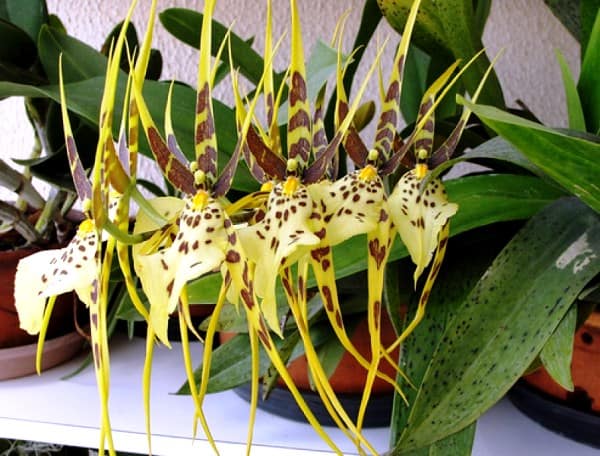 Brassia warty variety Summer — Dream
Brassia warty variety Summer — Dream
In an orchid, a flower shoot forms at the base of the last mature pseudobulbs between the leaves that surround them. The number of shoots depends on the size of the plant. Flowers are arranged on two sides, creating symmetrical pairs. Flowering lasts 4 to 8 weeks. A decrease in the daytime temperature of 20 ° C has a good effect on the durability of the flowers.
The flowers of the brassia hybrids are large, fragrant, with long, narrow petals, pointed and even curled at the ends. The color can be greenish-white, greenish-yellow, orange, brownish-yellow.
Almost all flowers are variegated, decorated with dark spots or colored red-brown at the base. The lip can be white or colored and often has several reddish-brown spots at the base. The floral scent is especially intense on sunny days.
Orchid varieties, names, descriptions and photos
There are endless varieties and varieties of orchids, among which the following can be distinguished:
Cattleya labiata
One of the largest representatives of cultivated orchids, although there are also small cattleyas. This variety has a very beautiful flower with wax-coated petals and a corrugated lip. The color of the orchid flower, which “lives” for almost three weeks, is the most versatile - from pale pink and beige tones to deep purple.

Cymbidium Orchid
An excellent variety of orchids, resistant to stress and unpretentious to care for. Hanging stalks contain 10-13 orchid flowers of the most unimaginable palette - from boiling white to purple or bright orange. This orchid variety blooms profusely and continuously for 8-10 weeks.

Lycaste aromatica
This orchid variety is loved by connoisseurs for its spectacular bright lemon-toned flowers with a delicate and persistent aroma. Peduncles are high, up to 25 cm, flowers in diameter often exceed 15-17 cm.

Darwinara's orchid
A miniature hybrid of an orchid with very dark, leathery leaves and a graceful inflorescence, including small, 2-3 cm in diameter, blue-violet flowers. The inflorescence is racemose, may contain 7-12 flowers with a delicate aroma.

Potinara Burana Beauty (Rhyncattleanthe)
The hybrid is distinguished by luxurious variegated yellow-red flowers, with wavy petals. The peduncle of an orchid of medium height, this orchid variety blooms all summer, and with proper care it pleases with beauty even in the first autumn month.

Cymbidium Twelve
An orchid with long, rather narrow leaves. The cymbidium "Twelve" orchid bud is whitish-pink in color, with a slight reddish speck. Inflorescences drooping, racemose, short.
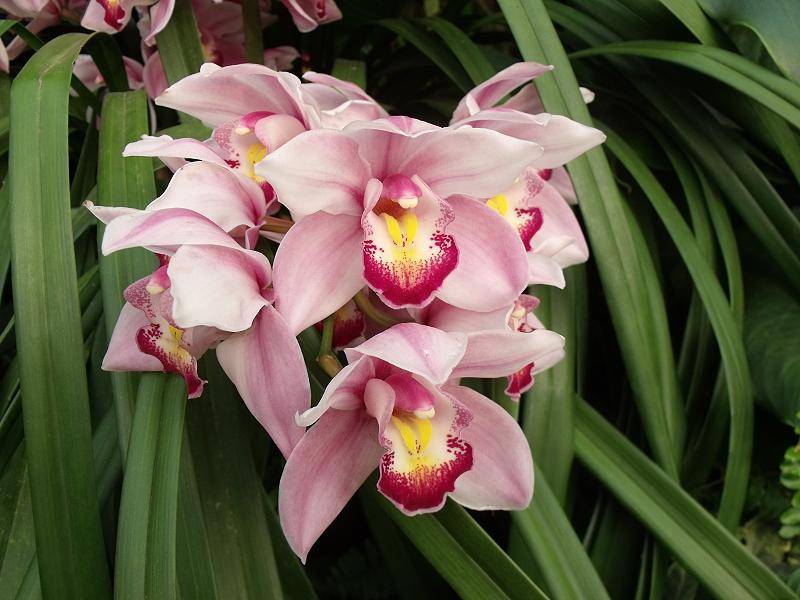
Orchid Dendrobium Nobile (Dendrobium nobile)
Dsometimes reaches 60 centimeters in height, the minimum growth of this individual is about 30 centimeters. The diameter of one bloom varies from 4 to 7 centimeters. And the branch of the Dendrobium Nobile orchid can have inflorescences of different tones.
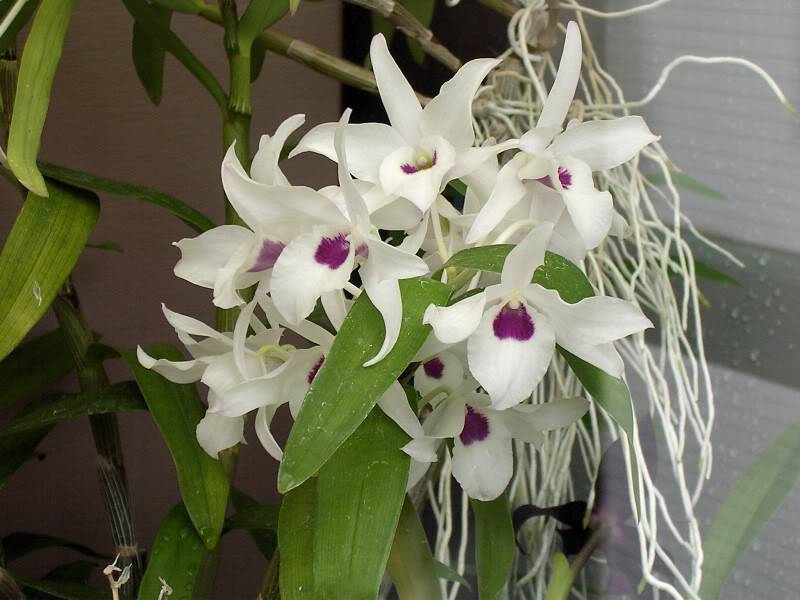
Conclusion
Orchid flowers were admired, they bowed down, considering them sacred, with their help they expelled dark forces and prepared love potions.
A symbol of elegance, luxury and patronage - the orchid at first glance won the hearts of not only the rich and noble. Today this splendor is available to everyone who wishes to enjoy the delightful beauty of Divine creation.
In the appearance of a beautiful and amazing orchid, all the beauty and grandeur of nature, with its diversity and splendor of colors and forms, is revealed. Indeed, the creator is perfect who created this inimitable magic called the orchid!


